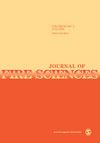Upward flame spread over discrete thin solids separated by heat-absorbing inert materials
IF 1.9
4区 工程技术
Q2 ENGINEERING, MULTIDISCIPLINARY
引用次数: 1
Abstract
Flame spread over discrete solid fuels has been of key research interest in the past few decades. Most studies considered an array of discrete fuels separated by air gaps or heat-insulating inert materials. The effects of heat loss due to the discrete configuration are not well understood. The present study aims to bridge this knowledge gap. A series of experiments are performed using a vertical array of thin discrete fuels separated by heat-absorbing inert materials of different thicknesses. For comparisons, experiments are also performed using discrete fuels separated by air gaps and using continuous fuel. The flame base spread rate is found to be generally higher in discrete fuel than in continuous fuel configurations, due to a reduced fuel load per unit length. It is also found that the air and inert gaps have opposite effects on the solid burning rates. The air gaps break the no-slip boundary, allowing the laterally entrained buoyancy flow (normal to the sample surface) to push the flame closer to the samples. This leads to an enhanced heat flux on the sample surface and an increased solid burning rate. On the other hand, the inert materials retain the flow boundary profile and act as a heat sink during flame spread, thereby reducing the solid burning rate. As the inert thickness increases, flame spread rate and solid burning rate decrease. Based on these observations, an existing model for flame spread rate is updated by incorporating the heat-absorbing effects of the gaps. The correlation is validated using the experimental data.向上的火焰蔓延在由吸热惰性材料隔开的离散的薄固体上
在过去的几十年里,离散固体燃料上的火焰传播一直是关键的研究兴趣。大多数研究都考虑了一系列由气隙或隔热惰性材料分离的离散燃料。离散配置引起的热损失的影响尚不清楚。本研究旨在弥合这一知识差距。使用由不同厚度的吸热惰性材料分离的薄离散燃料的垂直阵列进行了一系列实验。为了进行比较,还使用由气隙分离的离散燃料和使用连续燃料进行了实验。由于每单位长度的燃料负载减少,发现离散燃料中的火焰基本传播率通常高于连续燃料配置中的火焰基础传播率。还发现,空气间隙和惰性间隙对固体燃烧速率有相反的影响。气隙打破了无滑动边界,允许横向携带的浮力流(垂直于样品表面)将火焰推向样品。这导致样品表面上的热通量增加,固体燃烧速率增加。另一方面,惰性材料保持流动边界轮廓,并在火焰蔓延期间充当散热器,从而降低固体燃烧速率。随着惰性层厚度的增加,火焰蔓延速率和固体燃烧速率降低。基于这些观察结果,通过结合间隙的吸热效应,对现有的火焰传播率模型进行了更新。使用实验数据验证了相关性。
本文章由计算机程序翻译,如有差异,请以英文原文为准。
求助全文
约1分钟内获得全文
求助全文
来源期刊

Journal of Fire Sciences
工程技术-材料科学:综合
CiteScore
4.00
自引率
0.00%
发文量
14
审稿时长
2.5 months
期刊介绍:
The Journal of Fire Sciences is a leading journal for the reporting of significant fundamental and applied research that brings understanding of fire chemistry and fire physics to fire safety. Its content is aimed toward the prevention and mitigation of the adverse effects of fires involving combustible materials, as well as development of new tools to better address fire safety needs. The Journal of Fire Sciences covers experimental or theoretical studies of fire initiation and growth, flame retardant chemistry, fire physics relative to material behavior, fire containment, fire threat to people and the environment and fire safety engineering. This journal is a member of the Committee on Publication Ethics (COPE).
 求助内容:
求助内容: 应助结果提醒方式:
应助结果提醒方式:


